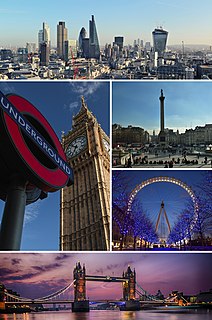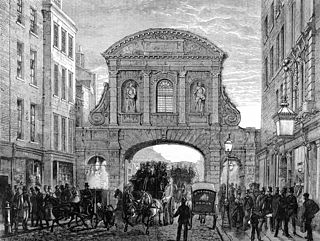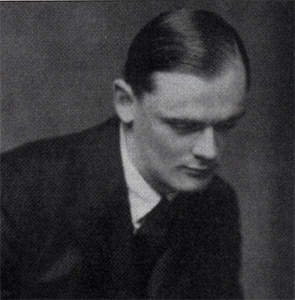
Crockford's, the popular name for William Crockford's St James's Club was a London gentlemen's club, now dissolved. It was established in 1823, [1] closed in 1845, re-founded in 1928 and closed in 1970. One of London's older clubs, it was centred on gambling and maintained a somewhat raffish and raucous reputation. It was founded by William Crockford who employed Benjamin Wyatt and Philip Wyatt to construct the city's most opulent palace of gentlemanly pleasure, which opened in November 1827. [2] and he employed two of London's finest chefs of the time, Louis Eustache Ude and then Charles Elmé Francatelli to feed its members, food and drink being supplied free after midnight. [3]

London is the capital and largest city of both England and the United Kingdom. Standing on the River Thames in the south-east of England, at the head of its 50-mile (80 km) estuary leading to the North Sea, London has been a major settlement for two millennia. Londinium was founded by the Romans. The City of London, London's ancient core − an area of just 1.12 square miles (2.9 km2) and colloquially known as the Square Mile − retains boundaries that follow closely its medieval limits. The City of Westminster is also an Inner London borough holding city status. Greater London is governed by the Mayor of London and the London Assembly.

A gentlemen's club, or traditional gentlemen's club, is a private social club originally set up by and for British upper-class men in the 18th century, and popularised by English upper middle-class men and women in the late 19th century and early 20th century.
William Crockford was an English Regency entrepreneur; horse racing enthusiast and proprietor of the infamous gambling club Crockford's who became one of the richest men in England.
Contents
From 1823, the club leased 50 St. James's Street, and then nos. 51–53, which enabled Crockford to pull down all four houses and build his palatial club on the site. After the club's closure, this continued to be used as a clubhouse, at first briefly by the short-lived Military, Naval and County Service Club, and then between 1874 and 1976 it was home to the Devonshire Club.

The Military, Naval and County Service Club was a London gentlemen's club, which was established in November 1848 and dissolved on 15 July 1851. The club's motto was "Cor Unum Via Una". Its original name was the Military & County Service Club and not long before it closed it was renamed as the Saint James's Club.

The Devonshire Club was a London gentlemen's club which was established in 1874 and was disbanded in 1976. Throughout its existence it was based at 50 St James's Street. The major Liberal club of the day was the Reform Club, but in the wake of the 1868 Reform Act's extension of the franchise, the waiting list for membership from the larger electorate grew to such an extent that a new club was formed to accommodate these new Liberal voters. The clubhouse was on the western side of St James's Street. The original intention was to call it the 'Junior Reform Club', along the model of the Junior Carlton Club formed in 1866, but complaints from the Reform Club's members led it to being named the Devonshire, in honour of its first chairman, the Duke of Devonshire, an aristocrat from a long line of Liberals.
The current Crockfords casino, though using much of the "Crocky" imagery and high-end reputation, has no connection with the original club and operates from an entirely different building at nearby 30 Curzon Street.







